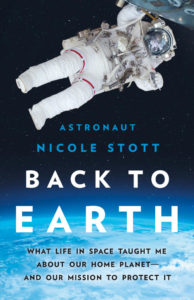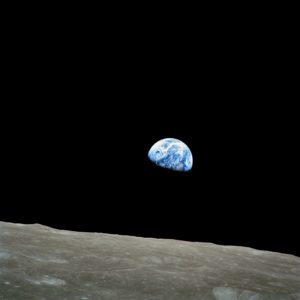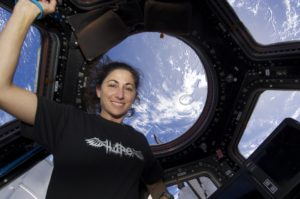Review by Laura Locke
Since I was very young, books have loomed large in my life. If you’re ever having trouble locating me, best bets are to check out the nearest library or bookstore, or possibly my couch. Over many decades of reading, I can say with conviction that my favourite non-fiction genres are history, biographies, travel, and science. Nicole Stott’s new book manages to bring together all four – and is a lively and very engaging read.
 Back to Earth: What Life in Space Taught Me About Our Home Planet – And Our Mission to Protect It (Seal Press, New York; 2021) is brimming with optimism, wit and intelligence, but also delivers an important warning about the current state of our environment. Stott is a retired American engineer whose NASA career spanned nearly thirty years. Part of that time was spent as a NASA astronaut, with two spaceflights and 104 days living and working as a crew member on the International Space Station. She is also an artist, and an aquanaut – but more on that later.
Back to Earth: What Life in Space Taught Me About Our Home Planet – And Our Mission to Protect It (Seal Press, New York; 2021) is brimming with optimism, wit and intelligence, but also delivers an important warning about the current state of our environment. Stott is a retired American engineer whose NASA career spanned nearly thirty years. Part of that time was spent as a NASA astronaut, with two spaceflights and 104 days living and working as a crew member on the International Space Station. She is also an artist, and an aquanaut – but more on that later.
Stott’s book starts with the story of the famous “Earthrise” photograph, taken on Dec. 24, 1968 by astronaut Bill Anders. Anders was part of the first crewed mission to orbit the Moon, aboard Apollo 8. His now-famous colour photo shows our glowing blue-and-white planet rising out from a backdrop of pitch-black space, with the grey, lifeless surface of the moon looming in the foreground.
Stott tells how in 2009, forty years after Apollo 11 astronauts left our planet to take a walk on the moon, she flew to space for the first time and experienced her own “Earthrise” moment. Seeing the Earth hanging in space from the windows of the Space Shuttle and later the International Space Station, she had a revelation – a strange, profound, and simple truth: we live on a planet.
She writes: “Experiencing Earth as a unified whole is more than an idea for astronauts; it’s a powerful reality. It is a message from the universe, intended not for space flyers alone but for all humanity. To understand the significance of Earthrise, we have to connect with these three simple lessons: we live on a planet, we are all Earthlings, and the only border that matters is the thin blue line of atmosphere that protects us all from the deadly vacuum of space.”1
Stott goes on to write movingly of the joys and struggles in her own early family life, as well as the steps on a remarkable journey that led to working for NASA, training to be an astronaut (which included an 18-day saturation dive mission in an undersea laboratory where she earned her ‘aquanaut’ status) and finally, travelling to space. We learn about the history of NASA’s space program and meet some of her heroes and friends who have been lights on her path. She also details how the International Space Station itself is an incredible marvel of both engineering and the human spirit.
Some of my favourite stories in the book arise from her personal experiences on the International Space Station (ISS), which for decades has featured a partnership between fifteen countries sending astronauts from around the world to live and work together in space. Stott relates fascinating (and often funny) insights about the ways that she and her crew members were constantly learning how to manage the challenges of living on the ISS, and how to work together as a team. They must, for example, learn to live with “microgravity” – the condition of virtual weightlessness or continuous free fall.
“To be able to float and fly is one of the unique things about living in space, and the most fun, but it also brings some of the greatest challenges. When I first got to space, I was a little clumsy as I tried to get used to life in three dimensions: I’d hold on too tightly to things, push off too hard, and try to reconcile some kind of up and down that didn’t exist. But our brains and bodies are incredible. We figure out very quickly how to adapt to new environments, even extreme ones.” 2
There are also negative side effects associated with microgravity, including weakened immune systems, bone loss, slower wound healing and cell behaviour changes. But the microgravity environment of the space station also gives opportunities to study and learn things that can benefit life on earth. Dr. Christopher Austin, director of the National Centre for Advancing Translational Sciences, explains that things that affect humans on Earth slowly affect astronauts much more rapidly – which provides an opportunity to study certain disorders on a time scale that would take much longer on Earth. Stott also gives an example of how experiments on protein crystals, used by scientists to study the structure of proteins for medicinal uses, are much easier to study in space. This is because they grow larger and form more perfectly in microgravity – and these are just a few of the many examples of the areas of fruitful scientific work being done on the ISS. One of Stott’s fellow astronaut classmates, Kevin Ford, came up with the phrase “Off the Earth, For the Earth”. This has now become the motto of the ISS program, and Stott writes that it is “beautifully appropriate.”
Another great example of work being done on the ISS that benefits life on Earth are its “sensors”. The ISS crosses about 80% of our planet’s surface as it orbits Earth, and these sensors monitor our vegetation, ocean surface conditions, harmful algae blooms in tropical coastal regions, floods, coral reefs, weather systems, impacts of natural and unnatural disasters, carbons emissions, and more – addressing a wide range of environmental and humanitarian concerns.
Stott’s other adventures onboard the ISS included a spacewalk, flying the robotic arm, and being the first person to paint a picture with watercolour in space.
The book is centered around seven “lessons” that Stott learned are key to the sustained success of the ISS program. Inspired by the words of inventor, architect, author and visionary Buckminster Fuller, she realized that these same lessons, which allow the astronauts to live and work and thrive on the Space Station, are also imperative for life on Earth to thrive and continue. Fuller wrote, “I’ve often heard people say, ‘I wonder what it would feel like to be on board a spaceship,’ and the answer is very simple. What does it feel like? That’s all we have ever experienced. We are all astronauts … aboard a fantastically real spaceship – our spherical Spaceship Earth.”3
The seven vital lessons – or indeed, as Stott calls them, “ways of being” – for both astronauts and Earthlings are:
Act Like Everything Is Local (Because It Is)
Respect the Thin Blue Line
Live Like a Crew, Not Like a Passenger
Never Underestimate the Importance of Bugs
Go Slow to Go Fast
Stay Grounded
Whatever You Do, Make Life Better
As she lays out the reasoning behind understanding and incorporating these lessons, Stott also introduces us to a number of Earthlings she has met who are working hard to effect positive change, telling fascinating stories about their lives and their zeal to improve life on our planet. Here are a few: Rowan Henthorn is a marine scientist and ocean advocate on the Isle of Man who is passionate about raising awareness and finding solutions for the devastating environmental impacts of single-use plastics and toxins on our world’s oceans. Anousheh Ansari is CEO of The X Prize Foundation, which designs and manages incentive competitions – awarding prize money from benefactors to enable social entrepreneurs to tackle humanity’s “grand challenges” in areas such as the environment, safety, energy and health. Dr. David Vaughan is a marine biologist who is doing amazing work on coral reef restoration, having found a way to reproduce thousands of fast-growing, resilient corals. Through Stott’s recollections of her encounters with these inspiring folks, we are given a chance to learn from her own curiosity and humility. Besides her storytelling abilities, she also has a way of helping us move beyond the idea of kinship with others to an awareness of something deeper, which includes all life on Earth.
“The willingness to acknowledge our interconnectivity allows us to experience our own Earthrise moment – to understand the uniqueness of our habitat here on Earth, our bodies’ unique attunement to life on Earth, and the urgency of the need for all of us to work as a crew to survive on Spaceship Earth.”4
Since her retirement, Stott has taken on a new, exciting “mission”. She is one of the four founding directors of the Space for Art Foundation. Its mandate is “to unite a planetary community of children through the awe and wonder of space exploration, and the healing power of art, working with children in hospitals, refugee centers, and schools.”
Yes, our problems here often seem totally overwhelming, but during Stott’s astronaut training and her time spent both in space and on Earth, she has discovered that truly wonderful things can be accomplished when people work together with focus and intention. It’s a timely message we all need to hear.
- Stott, Nicole. (2021) Back to Earth: What Life in Space Taught Me About Our Home Planet – And Our Mission to Protect It. Seal Press, New York. p. 4.
- Ibid., p. 20.
- Fuller, Buckminster. (1969) Operating Manual for Spaceship Earth. 1969. Carbondale: Southern Illinois University Press. pp. 54–55.
- Stott, Nicole. (2021) Back to Earth: What Life in Space Taught Me About Our Home Planet – And Our Mission to Protect It. Seal Press, New York. p. 39.









